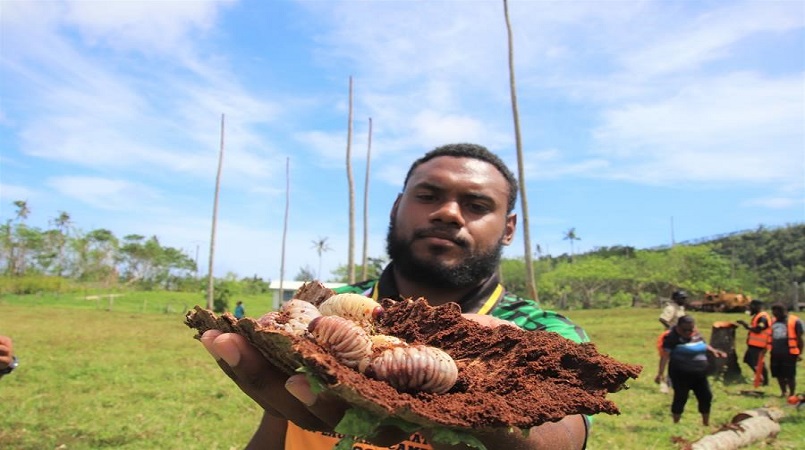
Consistent monitoring and surveillance of the deadly coconut rhinoceros beetle (CRB) in Vanuatu will be crucial for the biosecurity team following the destruction left behind by the two tropical cyclones Judy and Kevin that hit in March.
The alert comes as Vanuatu continues to rebuild after the deadly cyclones. The Pacific Community’s (SPC) entomologist Dr Mark Ero, who completed a visit to Vanuatu with his team from the New Zealand Ministry of Foreign Affairs and Trade (MFAT) funded Pacific Awareness and Response to Coconut Rhinoceros Beetle project last week, said the level of destruction on Efate Island, which is dealing with a beetle outbreak, is high and widespread.
Ero and his team are worried the dead logs and coconut palms left in the storms’ wake will pose a problem in the coming months as they are preferred breeding hosts for CRB.
“If the accumulated palm trunks are not cleaned and destroyed properly, they will become conducive breeding grounds for the beetle, enabling the population to explode, exacerbating damage levels and spreading further,” said Ero. “Considering the extent of the damage, additional manpower and resources and a workable action plan will be necessary to effectively destroy the palm trunks and prevent this potential population explosion.”
With funding support from MFAT, Biosecurity Vanuatu has been racing against time to contain the CRB spread on Efate. Acting director, Armstrong Sam said a ministerial order is in place to assist in controlling the movement of agricultural materials being exported from Efate to other islands.
“We urge residents of Port Vila and those close to town to get on board and help us get rid of the potential CRB breeding sites,” announced Sam. “They will need to chop the dead logs and branches into smaller pieces to use as firewood. Once they chop them up, they can put them in a heap and contact our biosecurity officers to spray fungus on them. For those in the outer islands, they can chop up these dead lying logs and burn them.”
The cyclones have resulted in the shipping of large amounts of relief supplies from Vanuatu’s capital. Vanuatu Biosecurity is urging ship owners and people moving the supplies to be aware of a ministerial order for ships to leave before 4 pm. If boats are docking at the wharf for the night, their lights must be lowered as CRB adults are attracted to the light and could hitch a ride. Many of the boats are carrying food supplies for the outer islands.
The CRB team also visited Ifira island, which recorded the presence of the Coconut Rhinoceros Beetle Guam strain or CRB-G. The team worked alongside the Vanuatu Biosecurity team in servicing the CRB traps that were placed on the island, including the artificial breeding sites sprayed with the Metarhizium fungus that has proven to be an effective CRB biocontrol agent.
In its role as the secretariat of the Pacific Plant Protection Organisation (PPPO), SPC is responsible for biosecurity activities in the region and remains dedicated to stamping out the coconut rhinoceros beetle, which continues to quickly spread across the Pacific. Ero and his team will continue to monitor and follow up on their efforts in Vanuatu to ensure the pest doesn’t get a new foothold in the country as cyclone recovery efforts progress.
Coconut Rhinoceros Beetle coordinator Joe Pakoawia holds bark containing CRB larvae in Vanuatu, in front of dead coconut palms infected by the pest - Credit: SPC
